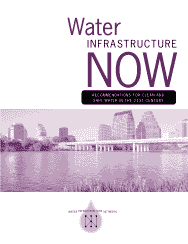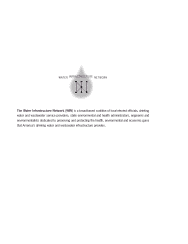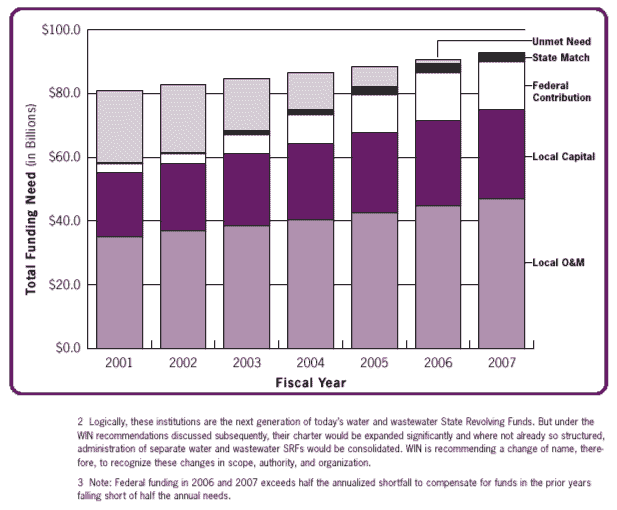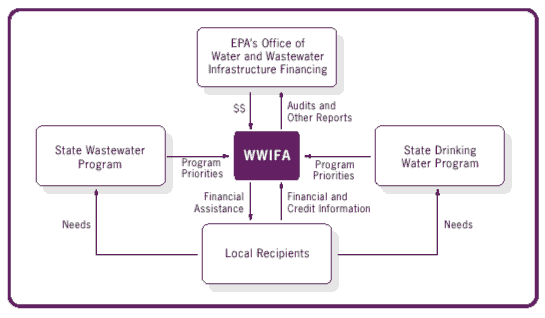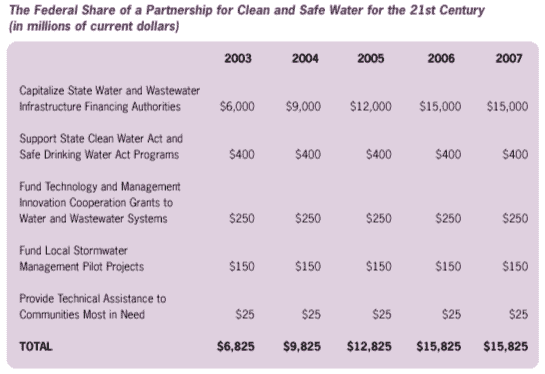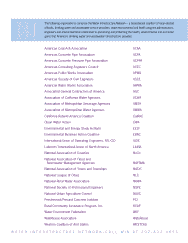|
Introduction In April 2000, the Water Infrastructure Network (WIN) released its first report, Clean & Safe Water for the 21st Century. That report documented significant improvements in water quality and public health associated with America's investments in water and wastewater infrastructure. But, it also documented an unprecedented financial problem: over the next 20 years, America's water and wastewater systems will have to invest $23 billion a year more than current investments to meet the national environmental and public health priorities in the Clean Water Act and Safe Drinking Water Act and to replace aging and failing infrastructure. EPA's own data and analyses corroborate the WIN figures. In the words of the WIN coalition, which represents a broad spectrum of professional, technical, academic, environmental, labor, and government organizations involved in water infrastructure: "New solutions are needed to what amounts to nearly a trillion dollars in critical water and wastewater investments over the next two decades. Not meeting the investment needs of the next 20 years risks reversing the public health, environmental, and economic gains of the last three decades." This second WIN report recommends a series of public and private actions that will be needed to meet the challenges for funding water and wastewater infrastructure over the coming decades. As part of this fiscal partnership, WIN recommends increasing the federal role where needs are great, public health or the environment is at risk, or local resources are inadequate. This enhanced federal role should provide for distribution of funds in fiscally responsible and flexible ways, including grants, loans, loan subsidies, and credit assistance. Investment in Water and Wastewater Will Yield Substantial Returns On this issue there is little disagreement &endash; investments in water and wastewater systems pay substantial dividends to public health, the environment, and the economy. It is well documented that wastewater treatment plants prevent billions of tons of pollutants each year from reaching America's rivers, lakes, and coastlines. In so doing, they help prevent waterborne disease; make our waters safe for fishing and swimming; and preserve our natural treasures such as the Chesapeake Bay, the Great Lakes, and the Colorado River. Clean water supports a $50 billion a year water-based recreation industry, at least $300 billion a year in coastal tourism, a $45 billion annual commercial fishing and shell fishing industry, and hundreds of billions of dollars a year in basic manufacturing that relies on clean water. Clean rivers, lakes, and coastlines attract investment in local communities and increase land values on or near the water, which in turn, create jobs, add incremental tax base, and increase income and property tax revenue to local, state, and the federal government. Some 54,000 community drinking water systems provide drinking water to more than 250 million Americans. By keeping water supplies free of contaminants that cause disease, our water systems reduce sickness and related health care costs and absenteeism in the workforce. By providing adequate supplies to industry that relies on pure water for processing, cooling, or product manufacturing, America's water systems create direct economic value across nearly every sector of the economy and every region of the country. By reducing illness and absenteeism, America's water systems contribute directly to the productivity of our workforce and continuous growth in Gross Domestic Product. Moreover, adequate water supply capacity to serve a growing industrial base enables expansion of the private economy. WATER INFRASTRUCTURE NOW Page-1 Local, State, and Private Sources Form Part of the Funding Solution Through water and sewer bills, local citizens and private businesses already pay about $60 billion a year or 90 percent of the total cost to build, operate, and maintain their water and wastewater systems. Increased local fees and taxes undoubtedly will help pay for a fair share of future system requirements, but local fees alone cannot solve all funding problems. Efficiency gains also could pay some of the bill. Future increases in local water and sewer rates could well be reduced as competitive pressures drive utility managers to adopt more efficient organizational structures, work practices, and new technologies. Many publicly owned and operated utilities have demonstrated that operating costs can be reduced by 20&endash;25 percent or more within a 3&endash;5 year period.1 But, WIN's estimate of the funding shortfall already deducts this "funding source" from its $23 billion total, so we can not count on operating efficiencies to meet more of our future needs. Private firms in the water and wastewater business also can play a key role. Their pressure to keep markets competitive will result in reduced costs of services overall. In addition, these companies can help finance new investments. But in the end, whether financing comes from local governments or private firms, local citizens and businesses will still have to pay the bills. The Federal Share in the 21st Century Will Be Critical Local solutions, like increased water and wastewater rates or operating efficiencies, can address only a portion of this problem. Financing the full $23 billion a year need with utility rate increases would result in a doubling of rates, on average, across the nation. If this were to happen, at least a third of the population of the U.S. would face economic hardship using EPA's conventional criterion for affordability. In small, rural, low-income, or older shrinking urban communities, economic hardships would be significantly more acute than the average. Protecting the nation's waterways from pollution and our drinking water from contamination will grow increasingly unaffordable if local communities are asked to pay the entire bill. In some locations, much of the shortfall in infrastructure finance is due to simple demographics. Over the next several decades, many cities will need to replace water and wastewater facilities and pipes that were installed in response to population growth and demographic shifts in the late 1800s and early 1900s. The next wave of infrastructure investment responded to postwar demographic changes in the 1920s and 1950s. Since the economic lives of materials shortened with each new investment cycle, many local utilities will face unprecedented funding hurdles as multiple generations of infrastructure wear out, more or less at the same time, over the next two decades. 1. See Association of Metropolitan Sewerage Agencies and Association of Metropolitan Water Agencies, Thinking, Getting , and Staying Competitive: A Public Sector Handbook, 1988. WATER INFRASTRUCTURE NOW Page-2 The Case for Federal Investment The case for federal investment is compelling. Needs are large and unprecedented; in many locations, local sources cannot be expected to meet this challenge alone; and because waters are shared across local and state boundaries, the benefits of federal help will accrue to the entire nation. Clean and safe water is no less a national priority than are national defense, an adequate system of interstate highways, or a safe and efficient aviation system. These latter infrastructure programs enjoy sustainable, long-term federal grant programs; under current policy, water and wastewater infrastructure do not. Equally compelling is the case for flexibility in the forms of federal investment including grants, loans, and other forms of assistance. Grants will be needed for many communities that simply cannot afford to meet public health, environmental, and/or service-level requirements. Loans and credit enhancements may be sufficient for other types of communities with greater economies of scale, wealthier populations, and/or fewer assets per capita to replace.
WATER INFRASTRUCTURE NOW Page-3
WIN Recommendations The Water Infrastructure Network recommends that Congress pass and the President sign and budget for new legislation to finance clean and safe water for America that:
WIN recognizes that no single solution addresses the full range of water and wastewater infrastructure and related challenges. All levels of government and the private sector must share responsibility for effective, efficient, and fair solutions. Each of these provisions is discussed subsequently. Long-Term, Sustainable, and Reliable Funding for Clean and Safe Water The importance of water and wastewater infrastructure was highlighted in the 1960s as the nation watched the quality of its waters decline precipitously and chose in the 1972 Clean Water Act to spend significant federal tax dollars to reverse this trend. Despite growing threats to public health, despite increasing federal mandates for cleaner water and safer drinking water, despite shifts in population that strand water and wastewater assets in urban core cities with few ways to pay for needed improvements, and despite the nearly universal need to replace hundreds of billions of dollars in aging and failing water distribution and wastewater collection systems, the federal contribution to water and wastewater continues to decline. Interestingly, this is not the case in other basic infrastructure systems such as highways, airports, transit systems, harbors, or waterways, for which Congress has continued to provide substantial federal funding. The rationale is simple: these basic infrastructure systems underpin the U.S. economy broadly and their benefits accrue widely to users without geographic limitations imposed by local political boundaries. Moreover, these infrastructure systems have network benefits that are felt only after all, or substantial portions, of the network is complete and functional, affording Americans anywhere in the country access to minimum levels of services. Water and wastewater infrastructure provide comparable economic and societal benefits.
WATER INFRASTRUCTURE NOW Page-4 Accordingly, WIN recommends that Congress renew its commitment to America's water resources with $57 billion in new authorizations and funding to capitalize state-administered grant and loan programs through Water and Wastewater Infrastructure Financing Authorities (WWIFAs).2 As depicted below, WIN recommends that appropriations ramp up over a five-year period to address, in a manageable fashion, the $23 billion annual shortfall in funding these critical infrastructure systems.
Over this five-year period, this level of funding is approximately half the capital funding shortfall.3 In the chart below, WIN has identified how this new federal contribution could augment other sources to eliminate unmet needs by 2007.
WATER INFRASTRUCTURE NOW Page-5 Looking simply at the capital portion of this funding plan, the chart below depicts the relative shares of an estimated $46 billion a year in capital funding needs for which each partner will be responsible over the first five years:
The state match in these graphs is simply 20 percent of federal capitalization grants. While it is difficult to predict exactly, actual state contributions could be significantly higher than amounts shown here since many states contribute more than 20 percent through overmatching and leveraging federal capitalization grants in the bond market. Consistent with the proportions of unmet needs identified in the April 2000 WIN Report, Clean and Safe Water for the 21st Century, WIN recommends that half the federal capitalization grant be reserved for investments in drinking water systems and half for wastewater systems. WIN recommends that states retain the flexibility to shift the use of their capitalization grant funds from water to wastewater or vice versa, with two conditions. First, neither water nor wastewater allocations in any year could drop below 35 percent of that state's annual capitalization grant as a result of such a transfer. Second, no funds could be transferred from water to wastewater (or vice versa) if such a transfer resulted in not funding a water project on the state priority list that was otherwise "ready to go," and vice versa. WATER INFRASTRUCTURE NOW Page-6 WIN recommends further that Congress continue funding in years beyond 2007 to help meet the $23 billion annual shortfall identified in Clean & Safe Water for the 21st Century. In that regard, WIN notes that in July 2000 the U.S. Congressional Budget Office estimated that the federal budget would generate a surplus of $4.6 trillion between 2001 and 2010 and a $2.1 trillion surplus over the five-year period 2003&endash;2007. 4 In 2003, at the outset of WIN's recommended federal funding initiative, Congress should establish a formal process to evaluate alternatives for, and recommend the structure of, a longer-term and sustainable financing approach to meet America's water and wastewater infrastructure needs. State Water and Wastewater Infrastructure Financing Authorities WIN recommends that federal funding be administered through flexible statewide water and wastewater banking institutions. These water and wastewater infrastructure financing authorities, or WWIFAs, would have broad latitude to meet needs within their states using appropriate combinations of grants, loans, and other financial assistance instruments. In general, the relationship between WWIFAs and other relevant state, local, and federal institutions is depicted below.
WIN contemplates that WWIFAs would be the next generation of today's state revolving funds. As such, they would have broad authorities to create affordable financial solutions to meet the investment needs of water and wastewater systems. They would handle the banking aspects of state water and wastewater infrastructure, working closely with state clean and drinking water programs 4 This includes both on- and off-budget surpluses. See: Congressional Budget Office, The Budget and Economic Outlook: An Update, (July 2000). 5 WIN contemplates a transition from SRFs to WWIFAs, the exact details of which must be worked out from state to state. Win does not contemplate creation of two parallel state funding institutions. WIN notes that some 30 states already operate WWIFA-like water and wastewater banking institutions, so transition issues, at least for these states, are likely to be minimal. WATER INFRASTRUCTURE NOW Page-7 that would translate program priorities to meet the mandates of the Clean Water Act and Safe Drinking Water Act into sequenced WWIFA funding needs. Sequencing would help ensure that the most critical public health needs were addressed first. WWIFAs would have broad latitude to meet all funding needs with packages of grants, loans, and other forms of assistance (see below) that met sequencing requirements and resulted in local water and sewer fees that were affordable according to state financial hardship guidelines. Just as EPA's water and wastewater program offices would interact on programmatic issues with their state counterparts, WWIFAs would interact on banking issues with EPA's new Office of Water and Wastewater Financing. This would effectively create separate, parallel funding and technical program delivery capabilities at both the federal and state levels. WWIFAs should encourage water and wastewater utilities to use value-based procurement policies within an asset-management framework. Grants WIN recommends that Congress require state WWIFAs to provide 25&endash;50 percent of each year's federal capitalization allotment as grants for up to 55 percent of the cost of eligible clean and safe water projects, except in hardship cases where grants could cover up to 75 percent of eligible project costs. In awarding grants, WWIFAs should take into account such factors as public health risk, environmental impairment, affordability, and service quality. Grants would be subject to reasonable terms and conditions. These considerations would address the financial problems that many water and wastewater systems would face if they had to finance all of their needs through local rates. Acute public health risks, for example, should not endanger our communities nor should environmental threats degrade our unique water resources where cause and effect is unclear, leaving public and private concerns to debate who should pay to restore a watershed. Affordability should not stand as a barrier to clean, safe, and reliable water in any community in America. Loans and Loan Subsidies Many communities can afford to pay for loans and, in many cases, there is little debate over cost-effective solutions. Accordingly, WWIFAs should have flexibility in the types of loans and loan subsidies they offer, including interest rate discounts, zero interest rate loans, principal forgiveness, and negative interest rate loans. WIN recommends that Congress require WWIFAs to allocate 10&endash;25 percent of each year's capitalization grant to loan subsidies. In addition, WIN strongly recommends loan terms of up to 30 years, provided such terms do not exceed the useful lives of investments. Loan subsidies of any form should be designed to minimize administrative burdens and collateral requirements. Issues of potential concern include local accounting, reporting, and auditing requirements; requirements for public approvals; and crosscutting federal requirements. Loan subsidies should be structured to be efficient and effective with no more requirements than those presently applicable to loan subsidies handled under the clean water and safe drinking water SRF programs. WATER INFRASTRUCTURE NOW Page-8 Other Types of Financial Assistance to Meet Needs WIN recognizes that other financial assistance mechanisms, including public-private partnerships, may address a portion of the problem. Congress, therefore, should authorize WWIFAs to use federal capitalization grants to:
As part of the federal funding package designed to lower the cost of capital for WWIFAs that choose to leverage their federal capitalization grants and for individual issuers seeking to borrow in the public capital markets, Congress should exempt from state private activity bond volume caps state and local private activity bonds for water and wastewater infrastructure, where such bonds (1) are used to finance core water or wastewater infrastructure, as defined below, and (2) produce public health or environmental protection benefits that are generally available to the public. This will greatly reduce the cost of financing water and wastewater infrastructure. As important, it will allow communities increased flexibility to more efficiently structure public-private partner-ships that bring together the particular strengths of both the public sector and the private sector.6 Funding Core Infrastructure Needs WWIFAs are broadly enabled banks for water and wastewater infrastructure and equivalent investments that yield clean and safe water. Accordingly, WIN believes that WWIFAs should focus on funding the following types of core investments, as identified in WIN's May 2000 report, Clean & Safe Water for the 21st Century:
6 For a more complete discussion of these issues, see: Environmental Financial Advisory Board to the U.S. Environmental Protection Agency, Incentives for Environmental Investment: Changing Behavior and Building Capital, August 9, 1991.
WATER INFRASTRUCTURE NOW Page-9 Since needs will vary from one system or one watershed to the next, WIN recommends that states set the following broad priorities for project-level investments under their WWIFA programs to:
WIN recommends that water and wastewater systems making investments in core infrastructure remain eligible for WWIFA assistance regardless of whether they are publicly or privately owned and/or operated as long as they provide water or wastewater services that are generally available to the public. Neither operations nor maintenance needs would be eligible for federal WWIFA funds. Using their own appropriated funds, states would be required to match 20 percent of federal capitalization grants. To avoid imposition of additional state fees, Congress should enable states to set aside sufficient portions of annual capitalization grants to administer these expanded programs. While decisions on individual projects would not be subject to federal approval, they would be subject to public review and comment. Streamlined Federal and State Administration Currently, two different offices within the U.S. Environmental Protection Agency interact with state finance authorities &endash; one handling water finance and the other handling wastewater finance. In addition, in about 20 states, separate water and wastewater agencies administer these financing programs. WIN recommends, therefore, that EPA form a new Office of Water and Wastewater Infrastructure Financing to oversee implementation of this new funding legislation. This office would consolidate the administration of grants to state WWIFAs. The director of this office should report to the Assistant Administrator for Water. This arrangement would streamline program delivery and partially separate funding and financial performance activities from regulatory program development and enforcement activities. Congress should authorize this new office to work with states, local borrowers, and other market participants through advisory panels to undertake a thorough analysis of, and recommend ways to streamline, inefficiencies in the administration of these funding programs. Recommendations should address the need to reduce federal and/or state paperwork requirements associated with federal funding assistance, simplify application processes, reduce oversight and reporting requirements where they no longer serve the federal or state interests, and provide flexibility in meeting requirements that do serve federal and state interests.
WATER INFRASTRUCTURE NOW Page-10 The State Role in Managing Clean and Safe Water Programs Under both the Clean Water Act and Safe Drinking Water Act, EPA delegates primary responsibility to the states to administer and enforce the national programs for clean and safe water. Each year, Congress appropriates grants to states to help pay their costs of administering these programs. Section 106 of the Clean Water Act authorizes EPA to provide Federal assistance to states (including territories, the District of Columbia, Indian Tribes) and interstate agencies to establish and implement ongoing water pollution control programs. Prevention and control measures supported by state water quality management programs include permitting, pollution control activities, surveillance, monitoring, and enforcement; advice and assistance to local agencies; and the provision of training and public information. The Safe Drinking Water Act gives states and Indian Tribes primary enforcement responsibility for public water systems in their jurisdictions if they meet certain requirements. Congress also provides grants under Section 1443 to state drinking water agencies to manage these delegated programs. Activities undertaken by the states continue to expand and include conducting sanitary surveys; monitoring and enforcing drinking water standards; training and certifying operators; reviewing plans and specifications for water systems; implementing source water assessments and capacity development programs; and providing emergency response, risk communication, disease surveillance, and technical assistance to local communities. Recent analyses have documented that federal grants to states have not kept pace with dramatic increases in costs of managing these federally delegated clean water and safe drinking water programs. While federal grants to support state drinking water programs may be used to provide up to 75 percent of a state program's costs, according to the Association of State Drinking Water Administrators, appropriations historically have covered only 35 percent. Accordingly, WIN recom-mends that Congress appropriate $400 million a year between 2003 and 2007 (in addition to the appropriations for WWIFA capitalization grants discussed earlier), or $200 million a year to help fund state implementation of the Clean Water Act and $200 million a year for state implementation of the Safe Drinking Water Act.
A New Program for Clean and Safe Water Technology and Management Innovation Technology and management innovation offer attractive solutions to high and rising costs of water and wastewater infrastructure. The rationale for technology research and development is simple: replacing existing and adding required new water and wastewater assets would cost more than $1 trillion, so improving the performance or longevity of only 1 percent of these assets would result in direct savings of $10 billion. Management innovation can continue to increase productivity at the nation's water and wastewater utilities, which in turn reduces operations and maintenance costs.
WATER INFRASTRUCTURE NOW Page-11 Recent innovations in the structure of organizations, the efficiency of reengineered work practices, and applications of technology have demonstrated O&M savings on the order of 15 percent to 40 percent. The federal government currently supports technology research and development through a variety of programs at the federal level including:
Yet, none of these programs focuses specifically on infrastructure. The AWWRF program is impressive at some $15 million a year, but only $1&endash;2 million a year is directed to infrastructure research. WERF's $10 million a year program similarly spreads resources across many subjects including infrastructure. The Association of Metropolitan Sewerage Agencies (AMSA), the Association of Metropolitan Water Agencies (AMWA), the Water Environment Federation (WEF), and the American Water Works Association (AWWA) independently and working together have advanced the concepts of competitiveness to improve water utility productivity and reduce operating costs. Currently, these groups are focused on new ways to manage water and wastewater utility assets. Much more work in these areas is needed. Accordingly, WIN recommends that Congress authorize $250 million a year (in addition to author-ization for WWIFA capitalization grants discussed earlier) to support an Institute of Technology and Management Excellence to promote the development and use of innovative technologies that would reduce the cost of meeting national clean and safe water requirements and replacing water and wastewater infrastructure. The Institute would offer 85 percent cooperation grants to water or wastewater systems and their private sector or university partners to develop new management techniques and technologies, demonstrate their performance and costs at the utility level, and dis-seminate results using an Institute-sponsored web learning center. The Institute would be charged with recommending to Congress and the states appropriate incentives to adopt new management approaches and/or technologies. The board of directors of the Institute would be comprised of pub-lic and private interests in clean and safe water.
WATER INFRASTRUCTURE NOW Page-12 In addition, WIN recommends that Congress authorize and appropriate $150 million a year between 2003 and 2007 for research and development pilot projects on stormwater management. These funds would go directly to local governments who want to engage in research or to demonstrate innovative approaches to managing separate storm sewer discharges more effectively.
Expand Technical Assistance for Communities Most in Need Technical assistance and capacity building for communities in need is low-cost insurance that funds will be wisely invested in water and wastewater infrastructure and that these facilities will be properly maintained and managed. Since proper maintenance improves operating performance and prolongs system life, both current operating and future replacement costs will be reduced. The federal government currently spends approximately $20 million a year on water and wastewater technical assistance to these communities through programs administered by the Environmental Protection Agency (EPA), the Department of Agriculture Rural Utilities Service (RUS), and various state programs. But, technical assistance needs are expected to grow with increases in funding for capital investment under the WIN recommendations. WIN therefore recommends that Congress authorize and fund an additional $25 million a year between 2003 and 2007 for technical assistance to communities in need. These funds would continue to be administered through existing programs.
Summary of Funding Recommendations The Water Infrastructure Network has found compelling evidence of water and wastewater needs that substantially exceed current investment levels. If we do nothing, the nation can expect increased threats to public health, environmental degradation, and real economic losses. At times and in places, these threats will be small and barely noticeable, but over the next two decades, and even more quickly in some locations, losses will mount and solutions will be financially unmanageable. The Water Infrastructure Network has recommended a series of actions, therefore, to strengthen the partnership among governments at the local, state, and federal levels and between public and private participants in the water and wastewater infrastructure community.
WATER INFRASTRUCTURE NOW Page-13 These actions will not be cost free. WIN is recommending that all levels of government and the private sector pay for needed investments in efficient, effective, and equitable ways. Despite the figures below that represent the federal share of this fiscal partnership, local government will still be paying 80 percent of the cost to build, operate, and maintain America's water and wastewater systems. The Water Infrastructure Network, a broad based coalition of organizations representing local elected officials, drinking water and wastewater service providers, state environmental and health program administrators, engineers, labor, and environmentalists, agree: this partnership is essential to water in the 21st century.
WATER INFRASTRUCTURE NOW Page-14 |

